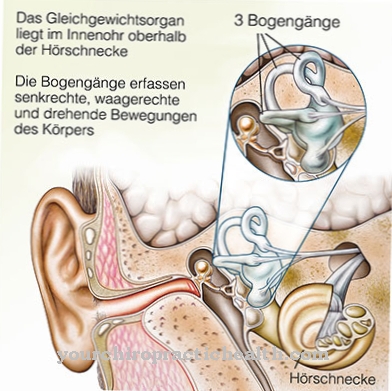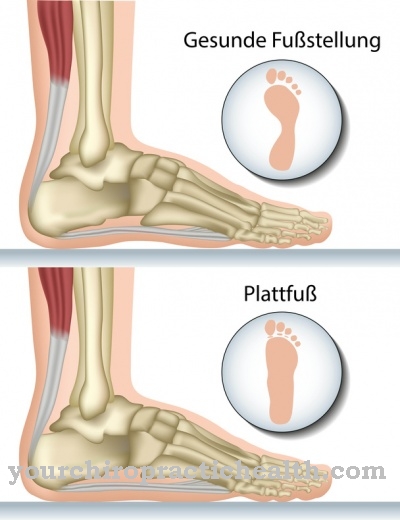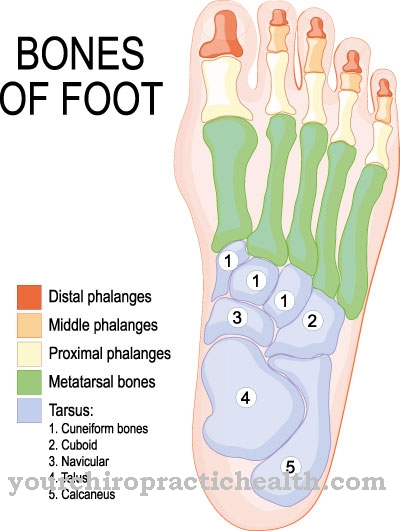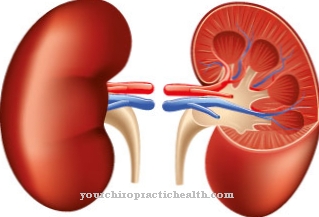A Subarachnoid hemorrhage is an acute intracranial hemorrhage (into the cranial cavity), which in most cases is due to an aneurysm rupture and has an unfavorable prognosis. Subarachnoid hemorrhage affects around 15 in 100,000 people each year.
What is subarachnoid hemorrhage?

© Henrie - stock.adobe.com
As Subarachnoid hemorrhage is an acute intracranial hemorrhage in the subarachnoid space, which is located between the arachnoid (cobweb skin) and the pia mater (vascular part of the meninges), which together form the soft meninges (leptomeninx).
Symptoms characteristic of a subarachnoid hemorrhage are sudden, very pronounced headaches in the area of the back of the head ("annihilation headache"), nausea and vomiting, meningism (stiff neck, sensitivity to light) and initial clouding of consciousness.
Later on, due to the increasing intracranial pressure, unconsciousness, coma, and cardiovascular and respiratory arrest are characteristic of subarachnoid hemorrhage.
causes
A Subarachnoid hemorrhage is most often due to a rupture of a cerebral artery aneurysm. A cerebral aneurysm is usually caused by a genetically determined weakness of the vascular wall in the area of the brain base, as a result of which bulges (aneurysms) develop on the vessels, which can burst (rupture) and lead to subarachnoid hemorrhage.
Aneurysm rupture is favored by physical exertion such as lifting heavy objects or sexual intercourse.
In more rare cases, head trauma, sinus vein thrombosis (occlusion of the large blood vessels in the brain), angiomas (vascular malformations), coagulation disorders and vascular inflammation can cause subarachnoid hemorrhage.
Hypertension (high blood pressure), nicotine consumption with hypercholesterolemia (high blood cholesterol levels) and drug consumption (heroin, amphetamines) are factors that promote the manifestation of aneurysms and thus subarachnoid hemorrhage.
Symptoms, ailments & signs
The first symptom of subarachnoid hemorrhage is usually a sudden and extremely severe headache known as an annihilation headache. Patients describe it as unbearable and never before experienced it in a similar way. The pain usually starts from the forehead or neck and extends over the whole head, sometimes even into the back. However, this symptom can also be absent.
In addition, those affected suffer from a stiff neck, nausea, vomiting and increased sensitivity to light. Blood pressure can go up or down, breathing rate changes, and body temperature fluctuates frequently. The pulse can beat irregularly and paralysis can occur.
Epileptic seizures are rare. Symptoms are divided into five grades by which the severity of the bleeding can be judged. Grade I only has a slight headache. Grade II shows more severe headaches and the neck is stiff. When grade III is reached, there is also drowsiness and minor neurological disorders such as paralysis or limited sensitivity.
Grade IV subarachnoid hemorrhage shows up in a coma-like sleep. In addition, there are breathing disorders and hemiplegia. Grade V has severe bleeding and the patient falls into a coma. The pupils no longer react to light stimuli and pronounced neurological disorders occur.
Diagnosis & course
A Subarachnoid hemorrhage is diagnosed on the basis of the characteristic symptoms, whereby the specific symptoms present provide information about the stage of the disease. Mild headaches and neck stiffness are associated with an early stage (grade I).
These intensify in the further course and can be accompanied by cranial nerve failure (grade II). Additional clouding of consciousness and neurological focus symptoms indicate grade III of the disease. Then symptoms such as somnolence or sopor (deep sleep), hemiparesis (hemiplegia), circulatory and respiratory disorders (grade IV) as well as coma, stretching cramps and impaired vital functions (grade V) can manifest themselves.
The diagnosis is confirmed by imaging procedures such as computed tomography (first week after a subarachnoid hemorrhage), magnetic resonance imaging or lumbar puncture (from the 8th day). Doppler sonography is used to rule out possible vasospasms (vascular spasms), while angiography enables conclusions to be drawn about the exact location of the aneurysm.
The prognosis is poor with subarachnoid hemorrhage. About half of those affected die within the first 30 days of subarachnoid hemorrhage. In addition, despite a successful operation, there is an increased risk of impairment of brain functions.
Complications
In the worst case, the subarachnoid hemorrhage can lead to death. However, this only occurs if the condition is not treated. Those affected primarily suffer from very severe headaches. These can also spread to the neighboring regions of the body and lead to pain there too.
In addition, those affected vomit and feel sick. These complaints also have a very negative effect on the patient's quality of life. A high sensitivity to light and noise can also occur with subarachnoid hemorrhage and make everyday life more difficult for those affected.
Many patients also have a very stiff neck and possibly pain in this area. In the further course of the subarachnoid hemorrhage, unconsciousness may occur, in which the affected person may injure himself if he falls. The bleeding is usually treated with surgery.
There are no particular complications and the symptoms can be alleviated. However, due to the bleeding, the risk of a stroke increases significantly, so that the person affected continues to require various therapies and examinations. It may also reduce the patient's life expectancy.
When should you go to the doctor?
This disease should always be treated by a doctor. The earlier the subarachnoid hemorrhage is recognized and treated, the better, in most cases, the further course of the disease. Only through an early diagnosis and subsequent treatment can further complications or complaints be prevented. If the subarachnoid hemorrhage is left untreated, it can lead to death in the worst case. A doctor should be consulted if the person concerned has a very severe headache. In most cases, the person affected can no longer concentrate and can no longer go about their normal everyday life.
A stiff neck and severe nausea associated with vomiting can also indicate subarachnoid hemorrhage. Some people are very sensitive to light or are even prone to epileptic fits. Should such an attack occur, go to a hospital immediately or call an emergency doctor. Usually, the subarachnoid hemorrhage can be detected by a general practitioner. For further treatment, however, a specialist and usually an operation is necessary. No general predictions can be made about the further course and life expectancy of the patient.
Treatment & Therapy
The therapeutic measures are aimed at one Subarachnoid hemorrhage on the stabilization of the general condition of the person affected by intensive medical care. If an aneurysm ruptures, the vascular sac is separated from the blood circulation in a surgical procedure and the subarachnoid hemorrhage is stopped.
Two surgical procedures are used for this. In the so-called clipping procedure, the aneurysm is isolated from the bloodstream with the help of special clips at the vascular outlet in order to rule out further intracranial bleeding. In addition to this procedure, which takes place directly on the brain, the coiling process, which is now more widely used, is used to insert a platinum micro-coil into the aneurysm using a catheter leading through the inguinal artery.
After the platinum coil has been placed, the coil winds up and as a result of the subsequent thrombosis, the meshes of the coil and thus the aneurysm are closed. Due to the increased risk of vascular occlusion, an appropriate thrombosis prophylaxis should be used postoperatively. If there are already vasospasms (vascular spasms) or if the person concerned is in a bad condition, the patient is usually treated conservatively until the spasm has subsided (at least 10-12 days) due to the increased risk of stroke, and attempts are made to maintain the blood flow as far as possible .
For this purpose calcium antagonists such as nimodipine and infusions are preferably used to dilute the blood while increasing the blood volume (hypervolemic hemodilution). Intubation and ventilation may be required. If the subarachnoid hemorrhage is based on an angioma, it is embolized in many cases to prevent recurrent hemorrhage. In addition, absolute bed rest is indicated after both conservative and surgical therapy to minimize the risk of rebleeding.
prevention
One Subarachnoid hemorrhage can only be prevented to a limited extent. Measures against high blood pressure, avoiding nicotine and excessive alcohol consumption as well as avoiding obesity through a healthy diet and regular exercise prevent aneurysm and thus indirectly a subarachnoid hemorrhage.
Aftercare
Sufferers of subarachnoid hemorrhage usually have only a few and only limited follow-up measures available. For this reason, the patient should consult a doctor at the first symptoms and signs of the disease so that further complications can be prevented. As a rule, no independent healing can occur, so that the person concerned is dependent on a medical examination and treatment.
The sooner a doctor is consulted, the better the further course of the disease is usually. Most of those affected are dependent on a surgical procedure, which usually also requires radiation therapy or chemotherapy. Regular checks by a doctor are also very important after removal in order to identify and treat other tumors at an early stage.
Those affected should generally rest and take it easy with this disease, although strict bed rest must be observed in serious cases. As a rule, this disease does not reduce the patient's life expectancy, and a general course cannot be predicted.
You can do that yourself
In most cases, the everyday life of those affected is characterized by heteronomy. Because the damage is almost always associated with permanent disorders. Everyday life should be adapted to the severity and complexity of the impairments, whereby the focus is always on self-help.
Relatives and carers can support those affected in everyday life by working according to the Bobath concept. The regulation of the muscle tone, the initiation of normal movement sequences and the promotion of body awareness are the three basic aspects. This results in an everyday life in which food intake, mobility, elimination, clothing and washing are supported. However, it is always necessary beforehand to resolve spastic paralysis through movement and to avoid negative stimuli such as cold hands. Physiological movement sequences can be supported, especially when performing everyday tasks such as brushing teeth, combing or eating, whereby the bilateral arm guidance must always be focused.
People who have had subarachnoid hemorrhage often suffer from reduced alertness. Therefore, the living situation needs to be redesigned accordingly and distractions removed. The brain can only adapt over time to a few stimuli.
Anosognosia, neglect or pusher syndrome greatly increases the risk of falling. Avoiding falls during positioning or mobilization must therefore always be taken into account, as this leads to further immobility and dependency.






.jpg)






.jpg)

.jpg)
.jpg)











.jpg)